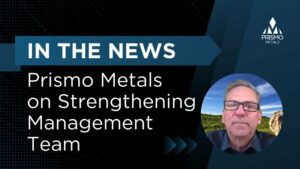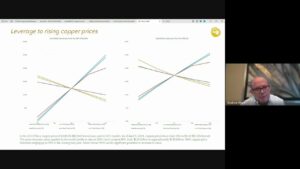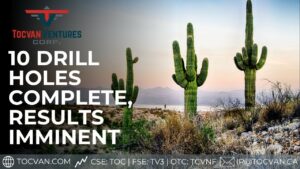KEY POINTS:
- Teck completed a 14-hole first diamond drilling campaign in December 2017
- Results suggest potential expansion of the Loma Bonita epithermal gold-silver mineralised system at depth south towards Cerro San Simon
- Confirmation of potential for porphyry copper mineralisation at Cerro Colorado
- Teck has informed Azure that it will be continuing exploration on Alacrán in 2018
- Geological, geochemical and geophysical surveys are being undertaken in the first half of 2018, to be followed by further drilling in the second half of the year
Azure Minerals Limited (ASX: AZS) (“Azure” or “the Company”) hereby provides an update on results from its 100%-owned Alacrán project (“Alacrán” or the “project”) located in Sonora, Mexico.
Project operator Minera Teck S.A. de C.V. (“Teck”), a 100%-owned subsidiary of Canada’s largest diversified resource company, Teck Resources Limited, is currently earning back into the project. Work conducted during 2017 represents the initial year of activity in a total four-year program comprising the first Option which will entitle Teck to earn back a 51% share of the project by sole-funding US$10 million of exploration expenditure and making cash payments to Azure totalling US$500,000.
Teck advised Azure in December 2017 that it had completed its first diamond drilling program at Alacrán, comprising 14 holes for 4,907m. Full and complete assays were received in early May and significant mineralised drill intercepts are detailed in Tables 1 – 3.
Furthermore, Teck has informed Azure that it will be continuing its exploration on Alacrán, with the Year 2 work program including additional geological, geochemical and geophysical surveys in the first half of 2018, which will be followed by more drilling in the second half of the year. The following summarises drilling and geological descriptions completed by Teck.
Overall Summary
Results from the 2017 exploration program suggest the potential expansion of the Loma Bonita epithermal gold-silver mineralised system at depth east and south towards Cerro San Simon (the Loma Bonita – Cerro San Simon Corridor) and confirmation of potential for porphyry copper mineralisation at Cerro Colorado (see Figure 1).
The Loma Bonita – Cerro San Simon Corridor has potential for significant gold and silver mineralisation, given the presence of untested zones of silicification covered by fresh rock and high-resistivity geophysical anomalies extending to depth. Focused efforts to distinguish areas of chalcedony mineralisation within the vuggy silica and silica-flooded units helped define drill targets.
Several blocks on the El Alacrán project area appear to have been faulted and displaced. The identification of these structural blocks has been important for narrowing down porphyry copper drill targets, specifically uplifted/tilted structural blocks, as present to the west of Cerro San Simon and in the area of Cerro Colorado.
First drilling at Cerro Colorado identified the presence of important amounts of secondary magnetite with quartz-magnetite veining and traces of chalcopyrite and molybdenite in pyrite-quartz and quartz veins and breccias. The presence of porphyry-type alteration and veining with trace copper and molybdenum mineralization is encouraging and warrants follow-up.
Loma Bonita – Loma Bonita Extension
At Loma Bonita, ALA-17-001 and ALA-17-001A were drilled to further test the Loma Bonita zone at depth. ALA-17-001 was abandoned at 138m due to stuck rods and re-drilled to a depth of 600.85m as ALA-17-001A, collared one metre to the east with the same azimuth and dip. The hole encountered vuggy silica and strongly silicified tuffaceous andesite, partly stratified, with lapilli and intervals of volcanic breccia in the first 160m. Vuggy and silicified volcanic breccia is dominant to depth of 350m. There are short intervals of oxidized chalcedonic material found throughout the first 450m. At 450m a feldspar-biotite porphyry was intersected with 5-10% disseminated pyrite mineralisation with small amounts of enargite (copper sulphide mineralisation). It continues nearly unchanged to the end of the hole.
Several holes were designed to test the extension of gold mineralised zones towards the east of Loma Bonita (Loma Bonita Extension), targeting geophysical resistivity anomalies under cover. Drill holes ALA-17-007, -008, and -011 were drilled through several tens of metres of mostly fresh porphyritic dacite which crops out atsurface to reveal leached vuggy silica and silica flooded brecciated tuffaceous units underlying a short section of clay-altered dacite. The sulphide zone is reached 200-300m downhole through oxidised rock. Continuation of volcanic breccia and feldspar porphyritic intrusive dykes and bodies are more common, containing between 5 and 15% disseminated pyrite with small amounts of copper sulphides.
Cerro San Simon
At Cerro San Simon four holes were drilled to test resistivity anomalies at or below surface, following up on encouraging gold results from previous drilling by Azure.
Hole ALA-17-004 was a 450 metre step out to the north of MDPD-035 and tested the southern continuation of the resistive layer connecting the Loma Bonita Extension and the silicified horizons of Cerro San Simon. The hole intersected vuggy silica zones with chalcedonic overprint near surface and from 203m to 217m, followed by significant pyrite and grey quartz mineralised igneoushydrothermal breccias. The hole ended in 60m of 5% pyrite mineralised quartz feldspar porphyry.
Hole ALA-17-003 was a 250 metre step-out to the east of MDPD-025 (31.5m @ 0.54ppm Au). A flooded silica zone hosted in a brecciated volcaniclastic was encountered from 53m to 87m depth, but the hole passed into fresh porphyritic andesite and was terminated.
Holes ALA-17-002 and ALA-17-006 were collared from the same pad and tested thick resistivity anomalies on the western side of Cerro San Simon. Both holes intersected zones of vuggy and chalcedonic silica zones, however hole ALA-17-006 remained in variable massive, vuggy, and chalcedonic silicified rocks with significant oxide mineralisation down to 409m depth.
Cerro Colorado
At Cerro Colorado four holes were drilled during the 2017 program, all of which were reconnaissance holes following mapped targets and geophysical anomalous features that resulted from IP surveys and airborne magnetics.
ALA-17-005 and ALA-17-009 targeted a high magnetic anomaly that straddles the southern property boundary. Additionally, several chargeability anomalies corresponding to disseminated pyrite zones show continuation to depth and were targeted with all Cerro Colorado holes.
ALA-17-005 intersected over 100m of strongly magnetic volcaniclastic to tuffaceous host rock units altered to chlorite and epidote, containing steeply dipping sheeted and banded quartz-magnetite veins with traces of chalcopyrite. All holes intersected disseminated pyrite (5-10%) with clay-illite alteration and pyrite-quartz veining, occasionally seen with anhydrite and as hydrothermal breccia cement.
ALA-17-010 intersected sections of hydrothermal breccia with traces of molybdenite. Visually, the core is considered encouraging, and a detailed review of geophysics, mapping, and drill results will be conducted.
Further Work
Teck has informed Azure that it will be continuing its planned exploration on Alacrán, which will comprise further geological, geochemical and geophysical surveys in the first half of 2018, to be followed by additional, results-driven drilling in the second half of the year. Potential targets to be tested include:
- following up positive results from the Loma Bonita – Cerro San Simon epithermal corridor and the Cerro Colorado porphyry copper target; and
- further epithermal precious metal and porphyry copper targets at La Morita, Santa Barbara and Cerro Alacrán.






Background to Alacrán Project
Azure earned 100% ownership of the Alacrán project from Teck in October 2016. In December 2016, Teck elected to exercise its right to earn back an ownership interest in the Alacrán project.
Work conducted during 2017 represents the first year of activity in a maximum four-year period for Teck to earn back a 51% share in the project.
Under the back-in agreement, Teck has an option to sole-fund US$10 million of exploration expenditure in accordance with the following schedule, and make cash payments to Azure totalling US$500,000:
| On or Before | Cumulative Aggregate Work Expenditures (US$) | Interest Earned |
| First anniversary | $2,000,000 (Expenditure met) | 0% |
| Second anniversary | $4,000,000 (Expenditure in progress) | 0% |
| Fourth anniversary | $10,000,000 | 51% |
Upon reaching an initial 51% interest in the project, Teck may further increase its interest to 65% by sole funding an additional US$5 million in expenditures over a further two years and making cash payments to Azure totalling an additional US$1.5 million. In this case, Azure will retain a contributing 35% interest in the Alacrán project. Grupo Mexico retains a 2% NSR royalty.
-ENDS-
For enquiries, please contact:
Tony Rovira Managing Director Azure Minerals Limited Ph: +61 8 9481 2555 | Media & Investor Relations Michael Weir / Cameron Gilenko Citadel-MAGNUS Ph: +61 8 6160 4903 |
of visit www.azureminerals.com.au
Original Article: http://azureminerals.com.au/wp-content/uploads/2018/05/180510_2.pdf

























